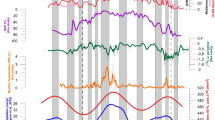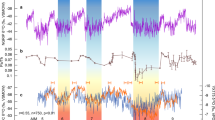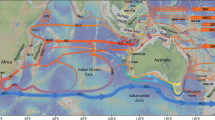Abstract
During the last ice age, the Indian Ocean southwest monsoon exhibited abrupt changes that were closely correlated with millennial-scale climate events in the North Atlantic region1,2,3, suggesting a mechanistic link. In the Holocene epoch, which had a more stable climate, the amplitude of abrupt changes in North Atlantic climate was much smaller, and it has been unclear whether these changes are related to monsoon variability. Here we present a continuous record of centennial-scale monsoon variability throughout the Holocene from rapidly accumulating and minimally bioturbated sediments in the anoxic Arabian Sea. Our monsoon proxy record reveals several intervals of weak summer monsoon that coincide with cold periods documented in the North Atlantic region4—including the most recent climate changes from the Medieval Warm Period to the Little Ice Age and then to the present. We therefore suggest that the link between North Atlantic climate and the Asian monsoon is a persistent aspect of global climate.
This is a preview of subscription content, access via your institution
Access options
Subscribe to this journal
Receive 51 print issues and online access
$199.00 per year
only $3.90 per issue
Buy this article
- Purchase on Springer Link
- Instant access to full article PDF
Prices may be subject to local taxes which are calculated during checkout



Similar content being viewed by others
References
Overpeck, J. T., Anderson, D. M., Trumbore, S. & Prell, W. L. The Southwest Monsoon over the last 18,000 years. Clim. Dyn. 12, 213–225 (1996)
Schulz, H., Rad, U. & Erlenkeuser, H. Correlations between Arabian Sea and Greenland climate oscillations of the past 110,00 years. Nature 393, 54–57 (1998)
Altabet, M. A., Higginson, M. J. & Murray, D. W. The effect of millennial-scale changes in Arabian Sea denitrification on atmospheric CO2 . Nature 415, 159–162 (2002)
Bond, G. et al. Persistent solar influence on North Atlantic climate during the Holocene. Science 294, 2130–2136 (2001)
Sirocko, F., Leuschner, D., Staubwasser, M., Maley, J. & Heusser, L. in Mechanisms of Global Climate Change at Millennial Time Scales (eds Clark, P., Webb, R. S. & Keigwin, L. D.) 113–126 (American Geophysical Union, Washington DC, 1999)
Prell, W. L. in Climate Processes and Climate Sensitivity (eds Hansen, J. E. & Takahashi, T.) 48–57 (American Geophysical Union, Washington DC, 1984)
Anderson, D. M. & Prell, W. L. A 300 kyr record of upwelling off Oman during the late Quaternary: Evidence of the Asian Southwest Monsoon. Paleoceanography 8, 193–208 (1993)
Naidu, P. D. & Malmgren, B. J. A high resolution record of late Quaternary upwelling along the Oman Margin, Arabian Sea based on planktonic foraminifera. Paleoceanography 11, 129–140 (1996)
Curry, W. B., Ostermann, D. R., Guptha, M. V. S. & Ittekkot, V. in Upwelling Systems: Evolution since the Early Miocene (eds Summerhayes, C. P., Prell, W. L. & Emeis, K. C.) 93–106 (The Geological Society, London, 1992)
Prell, W. L. & Campo, E. V. Coherent response of Arabian Sea upwelling and pollen transport to late Quarternary monsoonal winds. Nature 323, 526–528 (1986)
Clemens, S. C., Prell, W. L., Murray, D. W., Shimmield, G. & Weedon, G. Forcing mechanisms of the Indian Ocean monsoon. Nature 353, 720–725 (1991)
Gupta, A. K., Dhingra, H., Melice, J.-C & Anderson, D. M. Earth's eccentricity cycles and Indian Summer Monsoon variability over the past 2 million years: evidence from deep sea benthic foraminifer. Geophys. Res. Lett. 28, 4131–4134 (2001)
Barnett, T. P., Dumenil, L., Schlese, U., Roeckner, E. & Latif, M. The effect of Eurasian snow cover on regional and global climate variations. J. Atmos. Sci. 46, 661–684 (1989)
Meehl, G. A. Influence of the land surface on the Asian summer monsoon, external conditions versus internal feedbacks. J. Clim. 7, 1033–1049 (1994)
Bond, G. et al. A pervasive millennial-scale cycle in North Atlantic Holocene and Glacial climates. Science 278, 1257–1266 (1997)
Neff, U. et al. Strong coherence between solar variability and the monsoon in Oman between 9 and 6 kyr ago. Nature 411, 290–293 (2001)
Wang, L. et al. Holocene variations in Asian monsoon moisture: a bidecadal sediment record from the South China Sea. Geophys. Res. Lett. 26, 2889–2892 (1999)
Berger, A. L. Long-term variations of daily insolation and Quaternary climatic changes. J. Atmos. Sci. 35, 2362–2367 (1978)
Alley, R. B. et al. Holocene climatic instability: a prominent, widespread event 8200 years ago. Geology 25, 483–486 (1997)
Rind, D. J. & Overpeck, J. T. Hypothesized causes of decade- to century-scale climatic variability: climate model results. Quat. Sci. Rev. 12, 357–374 (1993)
Shindell, D. T. et al. Solar forcing of regional climate change during the Maunder minimum. Science 294, 2149–2152 (2001)
Anderson, D. M., Overpeck, J. T. & Gupta, A. K. Increase in the Asian SW monsoon during the past four centuries. Science 297, 596–599 (2002)
Keigwin, L. D. The little ice age and medieval warm period in the Sargasso Sea. Science 274, 1504–1508 (1996)
Jennings, A. J. & Weiner, N. J. Environmental change in eastern Greenland during the last 1300 years: evidence from foraminifera and lithofacies in Nansen fjord, 68°N. Holocene 6, 179–191 (1996)
Manabe, S. & Stouffer, R. J. Century-scale effects of increased atmospheric CO2 on the ocean-atmosphere system. Nature 364, 215–218 (1993)
Houghton, J. T et al. (eds) Climate Change 2001: The Scientific Basis (Cambridge Univ. Press, New York, 2001)
Trenberth, K., Olson, J. & Large, W. A global ocean wind stress climatology based on ECMWF analyses. Technical Note NCAR/TN-388 + STR, 1–93 (National Center for Atmospheric Research, Colorado, Boulder, 1989).
Reynolds, R. W. & Smith, T. M. A high-resolution global sea surface temperature climatology. J. Clim. 8, 1571–1583 (1995)
Janowiak, J. & Xie, P. CAMS-OPI: A global satellite-rain gauge merged product for real-time precipitation monitoring applications. J. Clim. 12, 3335–3342 (1999)
Stuiver, M. & Reimer, P. J. Extended 14C data base and revised radiocarbon age calibration program. Radiocarbon 35, 215–230 (1993)
Acknowledgements
A.K.G. thanks the US National Research Council for a senior research fellowship. J.T.O. thanks the US NSF Earth System History Program for supporting acquisition of AMS dates. We thank the Ocean Drilling Program for providing core samples.
Author information
Authors and Affiliations
Corresponding author
Ethics declarations
Competing interests
The authors declare that they have no competing financial interests.
Rights and permissions
About this article
Cite this article
Gupta, A., Anderson, D. & Overpeck, J. Abrupt changes in the Asian southwest monsoon during the Holocene and their links to the North Atlantic Ocean. Nature 421, 354–357 (2003). https://doi.org/10.1038/nature01340
Received:
Accepted:
Issue Date:
DOI: https://doi.org/10.1038/nature01340
This article is cited by
-
Spatiotemporal variation of rainy season span and precipitation recorded by lacustrine laminated pollen in the Tibetan Plateau during the past two millennia
Science China Earth Sciences (2024)
-
Possible linkage between climatic conditions and invasions on the Indian subcontinent during the period 6th century BCE to 16th century CE
Journal of Earth System Science (2024)
-
Transient vegetation degradation reinforced rapid climate change (RCC) events during the Holocene
npj Climate and Atmospheric Science (2023)
-
Holocene climate change in southern Oman deciphered by speleothem records and climate model simulations
Nature Communications (2023)
-
The indian monsoon variability during the last two millennia and links to the tropical equatorial Pacific
Climate Dynamics (2023)
Comments
By submitting a comment you agree to abide by our Terms and Community Guidelines. If you find something abusive or that does not comply with our terms or guidelines please flag it as inappropriate.



